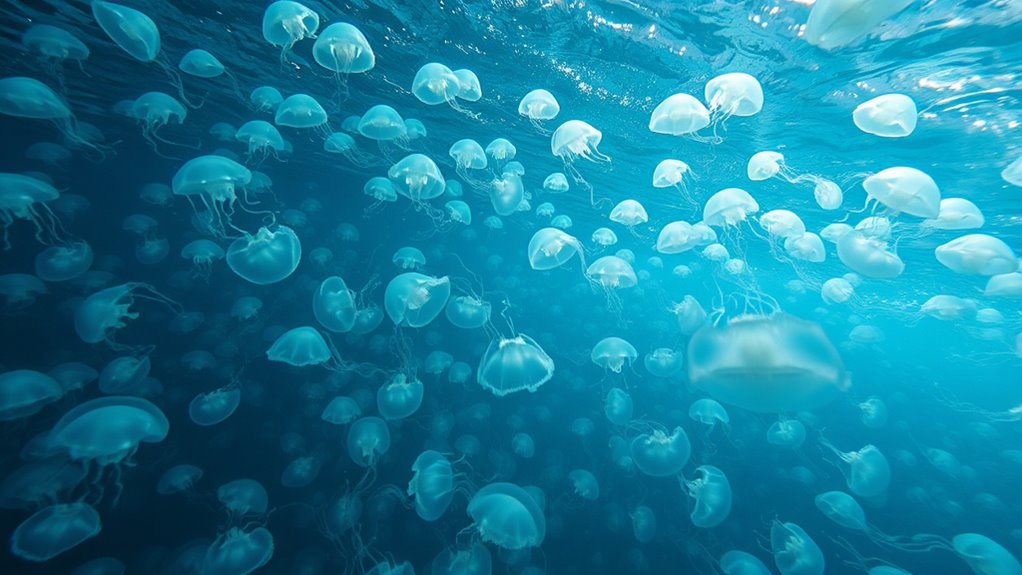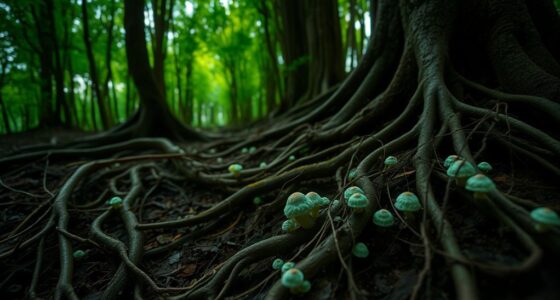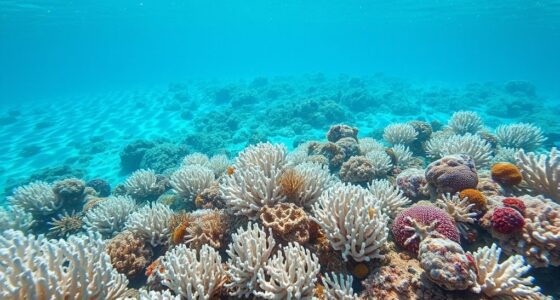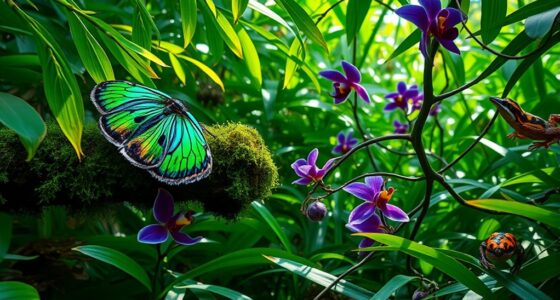Human activities like climate change and overfishing are creating ideal conditions for jellyfish blooms, transforming ocean ecosystems into what many call the “perfect ocean storm.” Rising temperatures and ocean acidification disrupt marine life balance, while overfishing reduces predators that keep jellyfish in check. These changes lead to more frequent and intense blooms that threaten fisheries, tourism, and marine biodiversity. To understand the full scope of how we’re shaping this issue, explore the details ahead.
Key Takeaways
- Human activities like climate change and overfishing create ideal conditions for jellyfish proliferation.
- Warming oceans accelerate jellyfish life cycles and reduce predators, fostering blooms.
- Overfishing decreases fish populations that normally control jellyfish numbers, enabling unchecked growth.
- Disrupted ecosystems and altered currents due to climate change promote jellyfish habitat expansion.
- These combined factors form a feedback loop, intensifying jellyfish blooms and creating a “perfect ocean storm.”

Have you ever wondered why jellyfish populations suddenly seem to explode into massive blooms? The answer lies in a combination of factors, with climate change and overfishing playing central roles. As global temperatures rise, ocean waters warm, creating ideal conditions for jellyfish to thrive. Warmer temperatures speed up their life cycles, allowing populations to grow faster and reproduce more frequently. Additionally, climate change leads to ocean acidification and altered currents, disrupting the delicate balance of marine ecosystems. These changes often diminish the populations of predators and competitors that normally keep jellyfish numbers in check, giving them room to expand unchecked. The resilience and adaptability of jellyfish also enable them to survive in low-oxygen environments where other marine life struggles, further aiding their proliferation.
Climate change and overfishing fuel jellyfish blooms by disrupting marine ecosystems and reducing natural predators.
Overfishing exacerbates the problem. When you remove large numbers of fish from the ecosystem, you’re unintentionally removing key predators that usually feed on jellyfish larvae or adult jellyfish. Without these natural controls, jellyfish have less competition and fewer enemies, allowing their populations to surge. Many fish species that prey on jellyfish are caught in large quantities for human consumption, and overfishing depletes these populations faster than they can replenish. This creates a void in the food chain, which jellyfish can quickly fill, especially since they are highly adaptable and capable of surviving in low-oxygen environments where other marine life struggles.
Furthermore, overfishing of plankton-feeding fish can lead to an increase in plankton populations, which are the primary food source for jellyfish. With fewer fish to consume plankton, the abundance of this tiny organism skyrockets, providing a rich food supply for jellyfish larvae and adults alike. This abundance of food, combined with warm, stable water conditions driven by climate change, fuels the rapid growth of jellyfish blooms. These blooms can then have cascading effects, such as blocking fishing gear, clogging cooling intakes at power plants, and disrupting local fisheries and tourism.
In essence, your actions—whether through climate change or overfishing—are shaping the ocean environment into a more hospitable habitat for jellyfish. This creates a feedback loop, where jellyfish populations continue to grow and dominate ecosystems, often at the expense of other marine life. So, when you hear about these massive jellyfish blooms, remember they’re not just natural phenomena—they’re symptoms of larger human impacts on the ocean. And unless we address the root causes, these blooms are only likely to become more frequent and intense, creating what many are now calling the perfect ocean storm. Understanding ecological impacts is crucial for recognizing how human activities influence marine ecosystems and the proliferation of jellyfish.
Frequently Asked Questions
How Do Jellyfish Reproduce and Increase Their Populations?
You might wonder how jellyfish reproduction boosts their population increase. They reproduce through a complex life cycle, starting with sexually produced larvae called planulae, which settle and become polyps. These polyps asexually produce medusae, the adult jellyfish. When conditions are right, this cycle accelerates, leading to rapid population growth. Human activities like pollution and overfishing can create favorable conditions, further fueling jellyfish reproduction and causing their populations to surge unexpectedly.
What Specific Human Activities Contribute Most to Jellyfish Blooms?
You should know that human activities like overfishing impacts and coastal development substantially contribute to jellyfish blooms. Overfishing removes predators and competitors, allowing jellyfish populations to explode. Coastal development disrupts habitats and increases nutrient runoff, fueling their growth. These activities alter the delicate balance of marine ecosystems, creating ideal conditions for jellyfish to thrive. By understanding this, you can recognize how your actions might unintentionally support these blooms and consider sustainable choices.
Can Jellyfish Blooms Harm Marine Ecosystems Beyond Coastal Areas?
Imagine a ripple spreading from a pebble, reaching deep into the ocean’s depths. Your actions cause jellyfish blooms that don’t stay near coasts but affect deep-sea impacts, disrupting marine biodiversity far beyond surface waters. These blooms can alter food chains, smother ecosystems, and threaten species essential for ocean health. So, yes, your influence extends beyond visible waters, harming the fragile balance of marine ecosystems deep beneath the surface.
Are There Natural Predators That Help Control Jellyfish Populations?
You might wonder if natural predators help control jellyfish populations. They do play a role in maintaining ecological balance, with species like sea turtles, some fish, and larger jellyfish preying on them. However, their effectiveness varies, and overfishing or environmental changes can reduce predator numbers. This imbalance often leads to unchecked jellyfish blooms, disrupting ecosystems and highlighting the need for understanding predator-prey dynamics to protect ocean health.
How Might Climate Change Alter Future Jellyfish Bloom Patterns?
Climate change acts like a brewing storm, stirring up unpredictable ocean patterns. As ocean acidification worsens, it affects jellyfish prey and predators, potentially fueling blooms. Thermal expansion raises sea temperatures, creating a warmer environment for jellyfish to thrive. You might see more frequent and intense blooms, disrupting ecosystems and fisheries. If these trends continue, the ocean’s balance could tip, making jellyfish blooms an even more persistent and problematic feature of marine life.
Conclusion
So, here you are, worrying about tiny creatures that seem harmless, yet their booming populations threaten your favorite beaches and fisheries. Ironically, by destroying their natural enemies and altering ocean conditions, we’re actually crafting the perfect storm for more jellyfish. Instead of controlling them, we’re fueling their rise. Maybe it’s time to reconsider our actions—because if we don’t, it’s you who’ll be swimming among the stinging reminders of our own mistakes.









